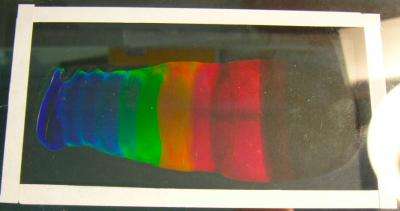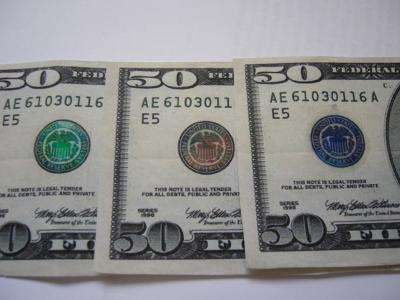Rainbows without pigments offer new defense against fraud

Scientists from the University of Sheffield have developed pigment-free, intensely coloured polymer materials, which could provide new, anti-counterfeit devices on passports or banknotes due to their difficulty to copy.
The polymers do not use pigments but instead exhibit intense colour due to their structure, similar to the way nature creates colour for beetle shells and butterfly wings.
These colours were created by highly ordered polymer layers, which the researchers produced using block copoylmers (an alloy of two different polymers). By mixing block copolymers together, the researchers were able to create any colour in the rainbow from two non-coloured solutions.
This type of polymer then automatically organises itself into a layered structure, causing optical effects similar to opals. The colour also changes depending on the viewing angle. This system has huge advantage in terms of cost, processing and colour selection compared to existing systems.
The complexity of the chemistry involved in making the polymer means they are very difficult for fraudsters to copy, making them ideally suited for use on passports or banknotes.
The academics used Diamond Light Source, the UK's national synchrotron science facility in Oxfordshire, to probe the ordered, layered structures using high power X-rays. This helped them understand how the colours were formed, and how to improve the appearance.

Dr Andrew Parnell, from the University of Sheffield's Department of Physics and Astronomy, said: "Our aim was to mimic the wonderful and funky coloured patterns found in nature, such as Peacock feathers. We now have a painter's palette of colours that we can choose from using just two polymers to do this. We think that these materials have huge potential to be used commercially."
Professor Nick Terrill, Principal Beamline Scientist for I22, the Diamond laboratory used for the experiment, explained: "Small Angle X-ray Scattering is a simple technique that in this case has provided valuable confirmatory information. By using Diamond's X-rays to confirm the structure of the polymer, the group was able to identify the appropriate blends for the colours required, meaning they can now tailor the polymer composition accordingly."
More information: To view the paper, 'Continuously tuneable optical filters from self-assembled block copolymer blends', published in Soft Matter, please see: pubs.rsc.org/en/content/articl … g/2011/sm/c0sm01320j
Abstract
We demonstrate that two symmetric high molecular weight diblock copolymers, of differing molecular weights, can be blended together and subsequently shear aligned to form one photonic structure without macrophase separation. The lameller period depends on the composition of the blend and gives a photonic structure that is easily tuneable in the wavelength range (λpeak = 400–850 nm).
Provided by University of Sheffield



















